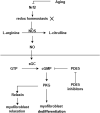Perspectives of PDE inhibitor on treating idiopathic pulmonary fibrosis
- PMID: 36865908
- PMCID: PMC9973527
- DOI: 10.3389/fphar.2023.1111393
Perspectives of PDE inhibitor on treating idiopathic pulmonary fibrosis
Abstract
Idiopathic pulmonary fibrosis (IPF) is a chronic, progressive interstitial lung disease (ILD) without an identifiable cause. If not treated after diagnosis, the average life expectancy is 3-5 years. Currently approved drugs for the treatment of IPF are Pirfenidone and Nintedanib, as antifibrotic drugs, which can reduce the decline rate of forced vital capacity (FVC) and reduce the risk of acute exacerbation of IPF. However these drugs can not relieve the symptoms associated with IPF, nor improve the overall survival rate of IPF patients. We need to develop new, safe and effective drugs to treat pulmonary fibrosis. Previous studies have shown that cyclic nucleotides participate in the pathway and play an essential role in the process of pulmonary fibrosis. Phosphodiesterase (PDEs) is involved in cyclic nucleotide metabolism, so PDE inhibitors are candidates for pulmonary fibrosis. This paper reviews the research progress of PDE inhibitors related to pulmonary fibrosis, so as to provide ideas for the development of anti-pulmonary fibrosis drugs.
Keywords: PDE inhibitor; anti-fibrosis; cAMP; cGMP; pulmonary fibrosis; senescence.
Copyright © 2023 Yang, Xu, Hu and Shen.
Conflict of interest statement
The authors declare that the research was conducted in the absence of any commercial or financial relationships that could be construed as a potential conflict of interest.
Figures




Similar articles
-
Efficacy of antifibrotic drugs, nintedanib and pirfenidone, in treatment of progressive pulmonary fibrosis in both idiopathic pulmonary fibrosis (IPF) and non-IPF: a systematic review and meta-analysis.BMC Pulm Med. 2021 Dec 11;21(1):411. doi: 10.1186/s12890-021-01783-1. BMC Pulm Med. 2021. PMID: 34895203 Free PMC article.
-
Real-life experiences in a single center: efficacy of pirfenidone in idiopathic pulmonary fibrosis and fibrotic idiopathic non-specific interstitial pneumonia patients.Ther Adv Respir Dis. 2020 Jan-Dec;14:1753466620963015. doi: 10.1177/1753466620963015. Ther Adv Respir Dis. 2020. PMID: 33070705 Free PMC article.
-
Antifibrotic therapy for idiopathic pulmonary fibrosis: time to treat.Respir Res. 2019 Sep 6;20(1):205. doi: 10.1186/s12931-019-1161-4. Respir Res. 2019. PMID: 31492155 Free PMC article. Review.
-
Possible value of antifibrotic drugs in patients with progressive fibrosing non-IPF interstitial lung diseases.BMC Pulm Med. 2019 Nov 12;19(1):213. doi: 10.1186/s12890-019-0937-0. BMC Pulm Med. 2019. PMID: 31718637 Free PMC article.
-
Real-World Study Analysing Progression and Survival of Patients with Idiopathic Pulmonary Fibrosis with Preserved Lung Function on Antifibrotic Treatment.Adv Ther. 2021 Jan;38(1):268-277. doi: 10.1007/s12325-020-01523-7. Epub 2020 Oct 24. Adv Ther. 2021. PMID: 33098554 Free PMC article.
Cited by
-
Pathological mechanisms and novel drug targets in fibrotic interstitial lung disease.Inflamm Regen. 2024 Jul 19;44(1):34. doi: 10.1186/s41232-024-00345-2. Inflamm Regen. 2024. PMID: 39026335 Free PMC article. Review.
-
Nerandomilast Improves Bleomycin-Induced Systemic Sclerosis-Associated Interstitial Lung Disease in Mice by Regulating the TGF-β1 Pathway.Inflammation. 2025 Aug;48(4):1760-1774. doi: 10.1007/s10753-024-02153-9. Epub 2024 Oct 23. Inflammation. 2025. PMID: 39438343
-
circGRHPR inhibits aberrant epithelial-mesenchymal transformation progression of lung epithelial cells associated with idiopathic pulmonary fibrosis.Cell Biol Toxicol. 2024 Jan 25;40(1):7. doi: 10.1007/s10565-024-09839-8. Cell Biol Toxicol. 2024. PMID: 38267743 Free PMC article.
-
BI 1015550 Improves Silica-Induced Silicosis and LPS-Induced Acute Lung Injury in Mice.Molecules. 2025 Mar 14;30(6):1311. doi: 10.3390/molecules30061311. Molecules. 2025. PMID: 40142089 Free PMC article.
-
Phosphodiesterase 4B (PDE4B) inhibitors and their applications in recent years (2014 to early 2025).Mol Divers. 2025 Jun 14. doi: 10.1007/s11030-025-11242-2. Online ahead of print. Mol Divers. 2025. PMID: 40515964 Review.
References
Publication types
LinkOut - more resources
Full Text Sources

